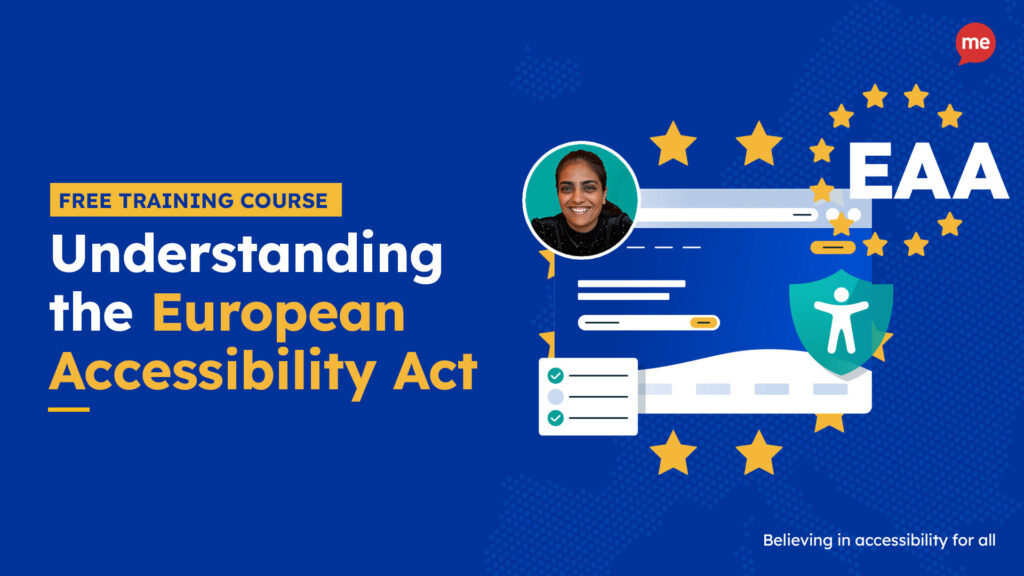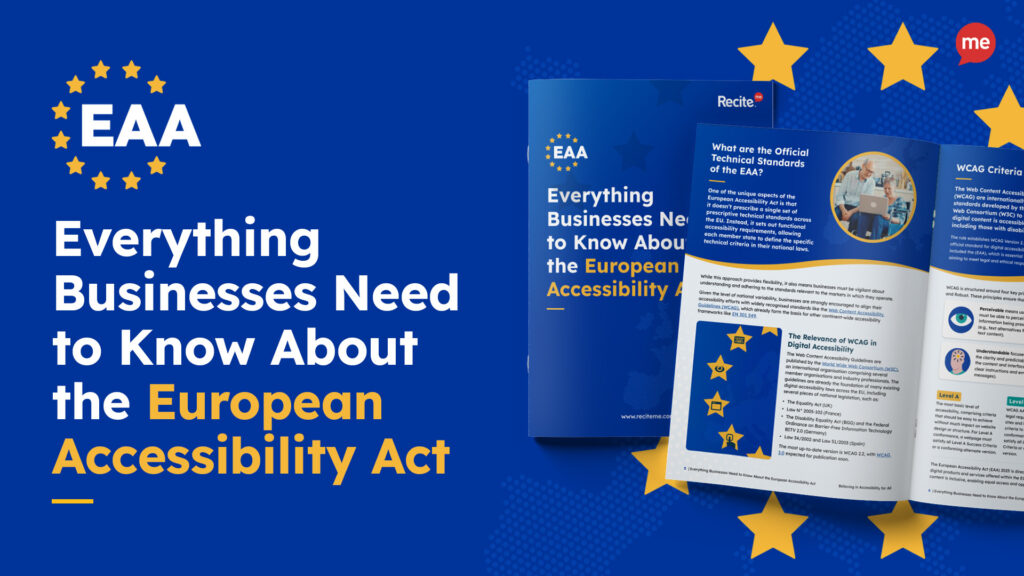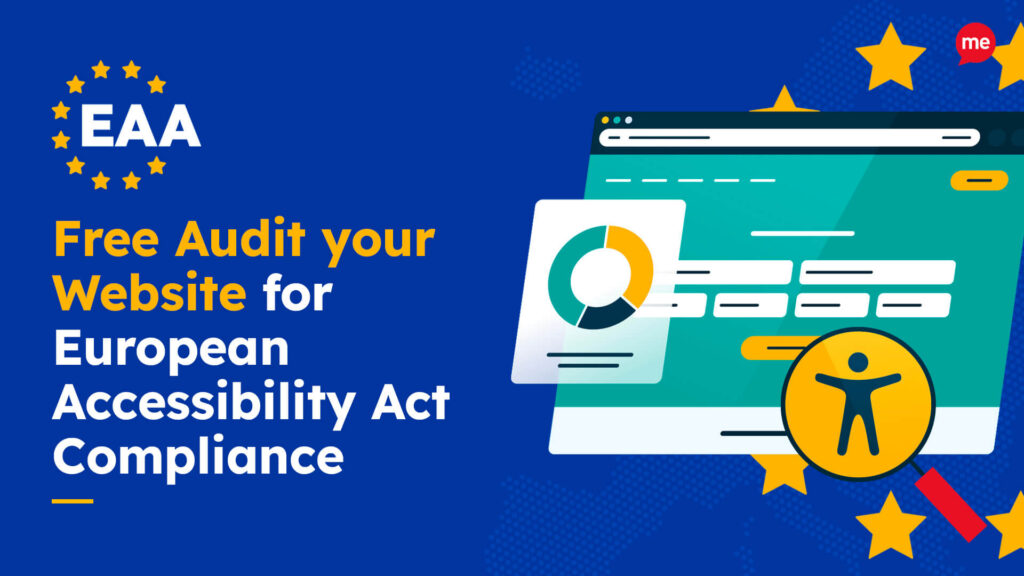Get Your Free European Accessibility Act Checklist
Download NowThe European Accessibility Act (EAA) is a critical law that every Belgian business should be aware of. Complying with it is not only a legal requirement, but helps you stay competitive for a long time. Navigating such a hefty piece of legislation can be rather daunting, which is why we’ve broken things down into digestible, bite-size chunks. So, whether you’re running an e-commerce platform, a bank, or doing any kind of business within Belgium or the EU, this article applies to you.
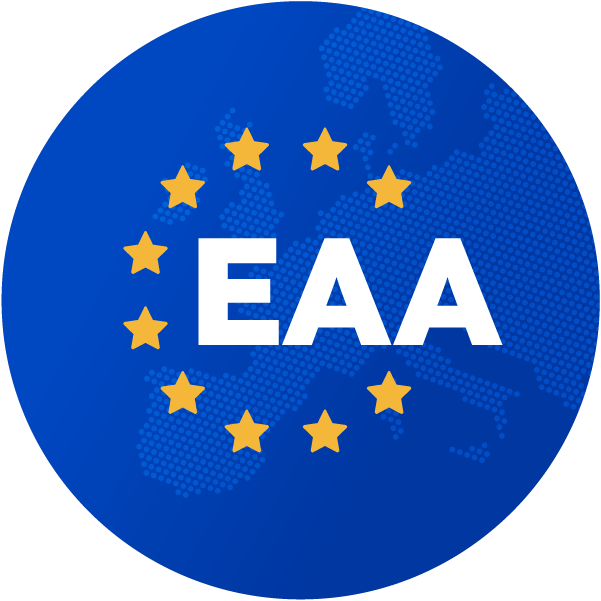
What is the European Accessibility Act (EAA)?
The European Accessibility Act (EAA) is a critical piece of legislation that was brought about in 2019, but was officially implemented in June 2025. It aims to standardising accessibility laws across member states of the European Union (EU). At its core, the act mandates that all organisations operating within the EU, including Belgium, whether public or private, must make their products and services accessible to those with disabilities.
It sets out requirements for a wide array of sectors, including banking, e-commerce, and telecommunications, touching both the physical and digital aspects of accessibility. This means making sure that things like ATMS, websites, mobile applications, and online documents, are designed to cater for the specific needs of individuals with physical, sensory, or cognitive impairments.
The EEA essentially makes it easier for European businesses to operate across borders by homogenising accessibility expectations throughout the EU. Consumers benefit from improved services and consistency across markets, while businesses are given the opportunity to capitalise on a huge market of disabled users that have been historically underserved.
Checking for EAA compliance is now easier than ever. At Recite Me, we offer a free website audit to spot any issues related to the European Accessibility Act and WCAG. You’ll get a clear action plan to help improve your website’s accessibility and meet EAA compliance.
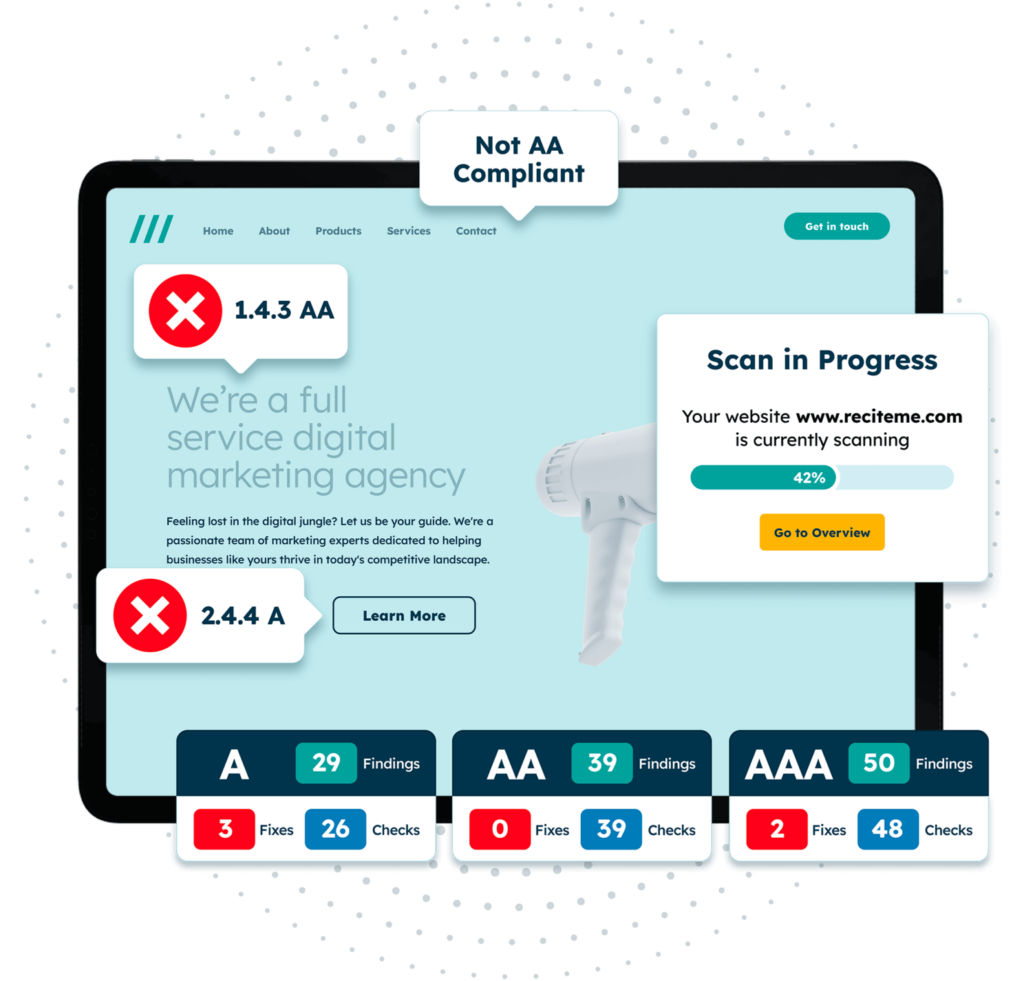
Which organisations in Belgium does the EAA apply to?
The EAA applies to any Belgian organisation that meets the following criteria:
- Trades within the EU
- More than 10 employees
- Annual turnover of more than €2 million.
So while there may be a few exceptions, the vast majority of Belgian businesses will need to comply with the EAA standards, ensuring all digital content is accessible.
Whether a bank, e-commerce retailer, or website owner of any kind, as long as you operate within the EU, and your organisation is not considered a microenterprise, you must comply with the EAA. Even if your organisation is based outside the EU, if it trades within any of the member states, the EAA’s requirements apply.
Web Content Accessibility Guidelines (WCAG)
The Web Content Accessibility Guidelines (WCAG) are a set of internationally-recognised standards, set out by the World Wide Web Consortium (W3C), for websites, mobile applications, and digital platforms. The guidelines prescribe specific requirements for achieving accessibility across a range of digital elements, including colour contrast, keyboard navigability, and compatibility with different types of assistive technology.
For each accessibility element, there are 3 sets of requirements (Level A, AA, and AAA). Which one you set your sights on depends on your resources, your commitment to accessibility, and the level of compliance you want to achieve. Take colour contrast, for example. Level AA requires a minimum contrast ratio of 4.5:1 for normal text, whereas Level AAA requires a slightly stricter contrast ratio of 7:1 for normal text.
WCAG best practices form the basis of the EAA’s digital requirements, meaning that in order to comply with the EAA, you must first comply with WCAG. A minimum of WCAG 2.1 Level AA compliance must be achieved in order to comply with the EAA.

Belgian Anti-Discrimination Act 2007
The Belgian Anti-Discrimination Act prohibits discrimination and hate speech based on characteristics, such as: age, sexual orientation, religion, wealth, disability, and more. In this way, the act makes equal access a legal right, designating accessibility a legal obligation for both public and private sector organisations, rather than a nice-to-have.
This serves as a foundation on which the EAA builds because, while the Anti-Discrimination Act establishes the principle that discrimination against people with disabilities is unlawful, the EAA operationalises this principle. It does so by setting concrete accessibility standards, via the WCAG, for a whole host of products, services, and sectors.
Important requirements for EAA compliance in Belgium
Now you have a good foundational understanding of the EAA and how it works, but how do you go about complying? In this section, we break down some of the EAA’s most important requirements, grouping them into several key areas, where each one addresses a different aspect of accessibility.

Website and mobile accessibility
Belgian businesses must ensure that their websites and mobile apps adhere to standards set out in the WCAG. This includes providing accessible alt text for images, making digital content readable, and ensuring website functions can be carried out using a keyboard only. You can get started with these changes using an EAA checklist.
Digital communication
Digital communication can take many forms, but is required by the EAA to be accessible. Typically, this includes the transfer of emails or online documents, such as PDFs, between two parties. Accessible emails must include a clear, logical structure and a readable font. Similarly, accessible PDFs should have a defined reading order, make use of tags for structure, and should ensure that any scanned images of text are made searchable using Optical Character Recognition (OCR).
Ecommerce accessibility
The EAA emphasises the need to make retail websites and eCommerce stores accessible to all customers. To achieve this, Belgian ecommerce businesses must ensure that every aspect of their website, but especially the checkout process, can be completed effectively by someone with visual, cognitive, or motor impairments. This might mean writing product descriptions that are simple and free of technical jargon, or ensuring that purchase forms are appropriately labelled and include instructive error messages.
Customer support options
Everyone should have access to help when they need it, not least those with disabilities. Under the EAA, Belgian businesses must provide accessible customer support options, which, as a bare minimum, should include phone call, in-person meetings, and email or live chat functions. This gives users, such as those with speech or hearing impairments who are unable to communicate effectively over the phone, an alternative means of reaching the support they need.
What are the consequences of European Accessibility Act non-compliance in Belgium
Failing to comply with the EAA carries with it a handful of risks that can impact your business’s finances, reputation, and, ultimately, its growth. Generally, these are interlinked, meaning that once a legal case is brought against your business for non-compliance, a domino effect of negative consequences follows. This section covers the main risks you should be aware of as a Belgian business owner.
Legal penalties
Perhaps the most obvious risk is the potential to face legal action and fines for European Accessibility Act non-compliance. To avoid recurring fines, businesses are typically required to make adjustments to their website or digital platform, incurring even further costs. Repeat violations could even result in suspension from operating within the EU market.
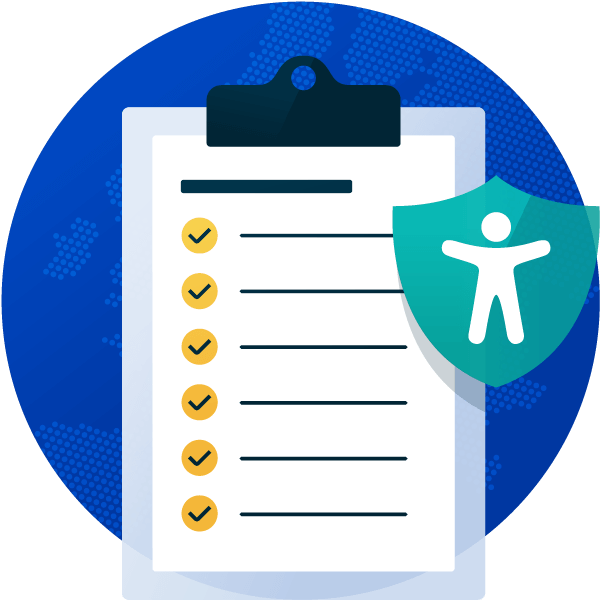
Brand reputation
The moment legal action is brought against your business for non-compliance with the EAA, it becomes very difficult to avoid damage to your brand’s reputation. If successful, a legal case could leave a hole in your customers’ loyalty, leading to increased rates of customer churn and deterring any future customers from doing business with you. Even if the case is not successful, the very fact that your business was involved in an accessibility-related lawsuit can paint your brand in a negative light.

Loss of market share
If your website does not comply with the EAA, this means that it is inaccessible. And, as we know, inaccessible websites are a huge bugbear for the millions of disabled internet users worldwide. The chances are, these users will not stick around and wait for adjustments to be made. Instead, they will opt for a more inclusive competitor, and your business will miss out on a vast pool of potential customers as a result.
Increased operational costs
While compliance with the EAA might be more of a time and financial investment at the beginning, it prevents higher operational costs further down the line. After all, it is much cheaper and easier to make proactive adjustments during the initial design phase of a website, rather than react to legal action in an attempt to avoid recurring fines.
Make sure your website meets the European Accessibility Act with our easy-to-follow EAA checklist. It covers all the key steps to get compliant before the deadline and helps you avoid penalties. Get started today!
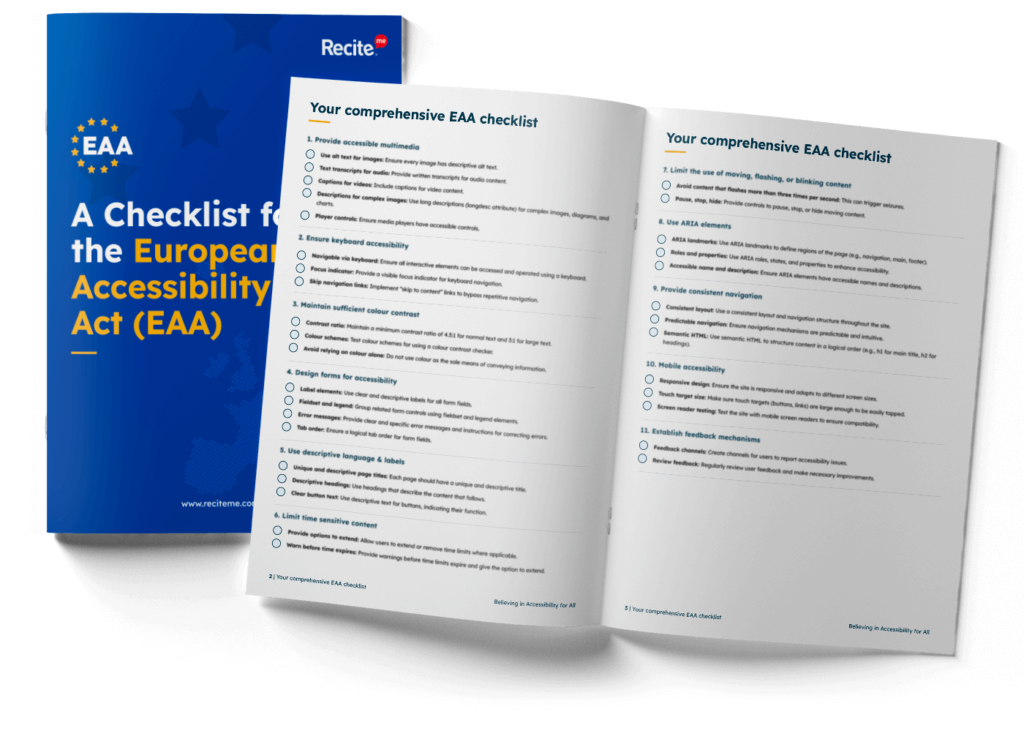
Steps to building a website that is compliant with the European Accessibility Act in Belgium
Creating an EAA compliant website in Belgium is not as simple as making a few adjustments and calling it a day. However, there is a clear process, which, if followed, will guarantee huge progress toward full EAA compliance.
Audit your site
Before you can make any adjustments, you need to identify your current accessibility level. Testing against WCAG with both automated and manual methods helps give a fair and comprehensive assessment of where you are in your accessibility journey and where you need to be. Some digital testing solutions, such as Recite Me’s accessibility checker, offer a report function, pulling together a list of accessibility improvements that need to be made and guidance for actioning these improvements in accordance with WCAG.

Regularly test and update
Unfortunately, testing is not a one-and-done process. Once accessibility has been achieved and your website has become EAA compliant, the goal is to maintain this accessibility standard long into the future. Schedule periodic audits and make use of automated tools to stay on top of any new issues that arise. Try to include user testing too, where you give free rein to a team of disabled internet users, allowing them to provide uncensored feedback on the accessibility of your website.
Train your team
Last but not least, it is important to train your team on accessibility best practices. This might involve seminars on manual testing, WCAG refreshers, or tutorials on interacting with disabled customers. Hosting regular training sessions helps your business maintain accessibility standards far into the future by embedding accessibility and inclusion into your company’s day-to-day.
At Recite Me we have our own dedicated training course for the European Accessibility Act that you can check out for free.
Make adjustments according to WCAG’s requirements
Equipped with the knowledge of your site’s current accessibility level, you can now begin targeting specific areas of your website. Imagine, for example, that a quick audit identifies insufficient colour contrast across your webpages. You can easily address this by checking the WCAG 2.1 Level AA standards for colour contrast and adjusting your palette accordingly. Work your way through each recommended improvement until your site is entirely accessible.
Need more help becoming EAA compliant?
The following resources are packed full of actionable tips and expert advice for making your digital content compliant with the European Accessibility Act:
Free EAA Compliance Training
Take the first step to European Accessibility compliance by completing our EAA training course.
Free EAA Compliance Guide
Ensure your organisation is meeting the necessary requirements for European Accessibility Act compliance.
Free EAA Audit of your Website
Download a free accessibility check of your website. This report will highlight any EAA non-compliance and how to fix it.

